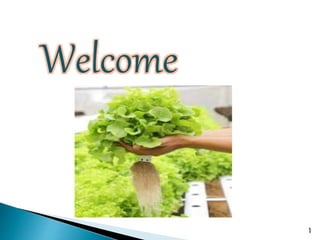
Hydroponics ppt
- 1. Welcome 1
- 2. A SEMINAR ON udY of HYDROPONIC TECHNOLOG PRESENTED BY, Miss. MULIK S. D. (SHE-2013/023) SUBMITTED TO, Prof. P. R. Juvekar 2
- 3. CONTENTS: 1. Introduction 2. History of Hydroponics 3. Hydroponic system 4. Why grow things Hydroponically ? 5. Working 6. Types of Hydroponic System 7. Materials used & Nutrient Solution 8. System Requirements 9. Advantages and Disadvantages 10.What can you grow ? 11.Conclusion 3
- 4. INTRODUCTION “Cultivation of plants in water” It is technique for growing plants without soil. Utilizing this technology, the roots absorb balanced nutrient dissolved in water that meets all the plant developmental requirements. Many aggregates and media support plant growth Also called as “ the cultivation of plants without using soil.” 4
- 5. HISTORY OF HYDROPHONICS Hydroponics became popularized by the news media in the 1920s when a scientist named Dr. William F. Gericke of the University of California when he put laboratory experiments in plant nutrition on a commercial scale. So he termed these nutriculture systems HYDROPONICS. The word was derived from the Greek words, HYDRO (water), and PONOS (labor), literally “water working”. 5
- 6. WHAT IS HYDROPONIC SYSTEM ? Photosynthesis process: Carbon Dioxide + Water → Glucose + Oxygen 6CO2 + 6H2O → C6H12O6 + 6O2 There is no mention of "soil" anywhere in there and that's all the proof you need that plants can grow without it. 6
- 7. WHY TO GROW THINGS HYDROPONICALLY ? Photo by courtesy of NASA Kennedy Space Center (NASA-KSC) 7
- 8. Benefits sometimes questioned….. Some hydroponic growers got many times greater yields than conventional methods. Because hydroponically grown plants dip their roots directly into nutrient-rich solutions, they get what they need much more easily than plants growing in soil. With smaller roots, you can grow more plants in the same area and more yield. Many pests are carried in soil, so doing without it generally gives you a more hygienic growing system with fewer problems of disease. 8
- 9. HOW DOES HYDROPONICS WORK ? Stand your plants in a plastic trough and let a nutrient solution trickle past their roots (with the help of gravity and a pump). 9
- 10. TYPES OF HYDROPONIC SYSTEM 1. Wick System 2. Water Culture 3. Ebb & flow (Drain and flow) 4. Drip system Recovery/ Non- recovery 5. N.F.T.(Nutrient film Technique) 6. Aeroponic system 10
- 11. 1. WICK SYSTEM 2. WATER CULTURE 11
- 12. 3. EBB & FLOW (DRAIN AND FLOW) 4. DRIP SYSTEM 12
- 13. 5. N.F.T. (NUTRIENT FILM TECHNIQUE) 13
- 14. 6. AEROPONIC 14
- 15. MATERIALS USED IN HYDROPONICS 1. Coco Coir Has an excellent air to water ratio with great water retention 15
- 16. 2. Rockwool A fibrous material made from melted rock . Not Biodegradable Hazardous to health Must be pH balanced Excellent water retention. 16
- 17. 3. Expanded clay Pellets Most popular media Drain quickly & ph neutral Reusable Used in ebb & flow, water culture 50/50 mix of clay and coco creates a breathable medium Heavy 17
- 18. 4. Potting soil (Perlite) Perlite + Coco Coir + Vermiculite Synthetic materials are puffed/ heated to produce light and porous material 18
- 19. Nutrient Solutions In Hydroponics, nutrient control is easy A nitrogen-rich Grow Formula A phosphorous and potassium-rich Bloom Formula & The results? Bumper crops of delicious fruits and vegetables every time. 19
- 20. Plants require 17 essential elements to grow and reproduce The first three are Hydrogen, oxygen and carbon Other 14 are: Macro-Elements: Nitrogen, Phosphorous, Potassium, Calcium, Magnesium, Sulfur Microelements: Iron, Manganese, Copper, Zinc, Boron , Chlorine, Molybdenum, Nickel 20
- 21. SYSTEM REQUIREMENTS pH Control 5.8 and 6.4, or slightly acidic Electrical Conductivity (EC) 1.2-3.5 Mho Horticultural Lighting Metal Halide (MH), High Pressure Sodium (HPS) lamps. Temperature and Environmental Control 68- 78 degrees F. 21
- 22. ADVANTAGES Higher yields achieved in a smaller space. Nutrients precisely controlled. Grow, bloom and boost formulas used at the appropriate growth stage. Indoor gardens grown using full-spectrum horticultural lighting. Soil-borne pests and diseases are eliminated. Weeds are eliminated. Plants are healthier and reach maturity faster. Automation is possible 22
- 23. DISADVANTAGES Cost of initial investment Production is management, capital and labor intensive. A high level of expertise is required. Daily attention is necessary. Specially formulated, soluble nutrients must always be used. Some water born diseases can spread rapidly in recirculation system. 23
- 24. WHAT CAN WE GROW ? 24
- 25. WE CAN GROW HYDROPONIC GARDEN AT OUR HOME …. USING JUST WATER BOTTLES 25
- 26. WHAT WE ARE BUILDING… 26
- 27. 27
- 28. CONCLUSION Progress has been rapid and results obtained in various countries have proved that this technology is thoroughly practical and has very definite advantages over conventional methods of crop production. The main advantages of soil-less cultivation is the much higher crop yields. People living in crowded city streets, without gardens, can grow fresh vegetables and barren and sterile areas can be made productive at relatively low cost. 28
- 29. 1. MUNÕZ, Héctor. 2005. Hydroponics Home-based Vegetable Production System Manual. IICA, Georgetown, Guyana 2. ECHEVERRIA, Laura Perez. 2008. Hydroponics for Home. IICA, San Jose, Costa Rica 3. ROBERTO, Keith. Fourth edition. Hydroponics Technology. REFERENCES 29
- 30. 30